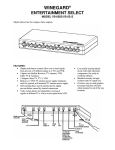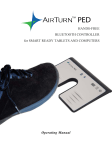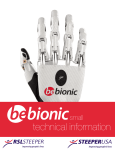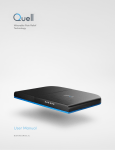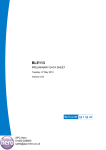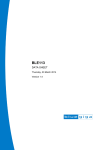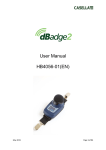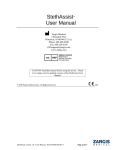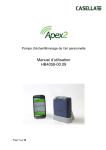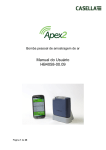Download Eko Core, Model 1 User Manual v. 001
Transcript
Eko Core, Model 1 User Manual v. 001 Contents Introduction, Warnings, & Safety Contact Information Installation Core Use Cleaning Warranty Operating Conditions Core Modes and LED States Eko App Use Electrical Safety 3 4 4 11 12 14 14 14 16 17 28 1.1 Introduction, Warnings, and Safety The Eko Electronic Stethoscope System (herein referred to as Eko) is designed to support healthcare professional in analyzing cardiac and other internal organ sounds. Eko includes a device that is attached to a stethoscope (Core), a smartphone application (App), and a web application (Dashboard). Core features sound amplification and audio transmission to a smartphone via Bluetooth that allows the user to open and playback sounds in a mobile application on compatible iOS smartphones and tablets. The app provides the ability to save sounds within Electronic Health Records (EHR) systems, share patient records with other practitioners, and annotate notes on recorded audio. Eko is intended for use on pediatric and adult patients. CAUTION: Federal (USA) law restricts this device to sale by or on the order of a clinician. 1.2 For Help and Assistance Please report any injury or adverse event to Eko Devices using any of the contact methods below. For general and product related comments, questions, or concerns, please contact Eko Devices, Inc. directly Eko Devices, Inc. 2600 10th St. Suite 260 Berkeley, CA 94710 USA General Assistance and FAQs www.ekodevices.com/support Direct Contact [email protected] Phone Support 1.844.356.3384 Product Reference and Information © 2015 Eko Devices, Inc. 4 www.ekodevices.com 1.3 Safety Related Labels & Symbols Consult instructions for use. This product contains electrical and electronic components and must not be disposed of using standard refuse collection. Please consult local directives for disposal of electrical and electronic equipment. This product and packaging does not contain natural rubber latex. This product contains an intentional RF radiator certified by the FCC. Catalog Number Batch Number Serial Number 93% Humidity Limit (Operational) 15% -30˚C (-22˚F) 40˚C (104˚F) Temperature Limit (Operational) This product is provided non-sterile. Do not attempt to re-sterilize the device. This product uses wireless Bluetooth communication. 1.4 Signal Word Consequences CAUTION: NOTICE: Indicates a hazardous situation, which if not avoided, could result in injury and/ or property damage and/or damage to the device. Indicates a hazardous situation, which, if not avoided, may result in property damage. 5 CAUTION: • To reduce the risk of device interference, keep the Eko Core at least 1 meter away from all RF emitters including Wifi routers and radios. • To reduce the risks associated with infection follow all cleaning and disinfecting instructions included in this manual. Establish and follow a cleaning and disinfecting schedule. • To reduce the risks associated with inaccurate data acquisition store and operate this stethoscope only as instructed in this manual. Though there is an acoustic (nonamplified) mode available with this stethoscope, it is highly recommended that the battery be recharged within thirty minutes of the LED indicator turning red. Recharge the battery using only the USB power cord and charger provided with the device. • DO NOT immerse the stethoscope in a liquid or subject it to any sterilization processes other than those described in this manual. • To reduce the risks associated with very strong electromagnetic fields avoid using the stethoscope near strong radio frequency (RF) signals or portable and/or mobile RF devices. If sudden or unexpected sounds are heard, move away from any radio transmitting antennas. Using accessories, transducers, and cables not produced by Eko Devices may result in increased RF emissions or decreased immunity of the Eko Electronic Stethoscope System. • Please read, understand, and follow all safety information contained in these instructions prior to using the Eko Electronic Stethoscope System. It is recommended that these instructions be retained for future reference. • To reduce the risk associated with an electrical shock do not use the stethoscope on patients without the analog stethoscope’s chest piece in place. • Core Model 1 contains a Bluetooth Class 2 wireless data link. The maximum radio frequency field strength generated by the stethoscope is below three volts per meter, a level that is considered safe to use with other medical devices. However, audio, video, and other similar equipment may cause electromagnetic interference. If such devices are encountered © 2015 Eko Devices, Inc. 6 NOTICE: and cause interference, immediately move Core away from that device and/or turn the Bluetooth feature OFF. • To reduce the risks associated with environmental contamination follow applicable regulations when disposing of this stethoscope. The Eko Core stethoscope attachment contains a lithium-ion polymer rechargeable battery; please properly dispose of the device as mandated by local directives. • No modification of this equipment is allowed. There are no repairable parts inside the Eko Core. 1.5 EMC Compliance FCC Intentional Radiator Certification Contains FCC ID: QOQBLE113 Contains IC: 5123A-BGTBLE113 This equipment contains an intentional radiator approved by the FCC under the FCC ID numbers shown above. This device complies with Part 15 of the FCC rules. Operation is subject to the following two conditions: (1) This device may not cause harmful interference, and (2) this device must accept any interference received, including interference that may cause undesirable operation. NO MODIFICATION: Modifications to this device shall not be made without the written consent of Eko Devices, Inc. Unauthorized modifications may void the authority granted under Federal Communications Commission rules permitting the operation of this device. EMC Compliance Europe This equipment complies with the EMC requirements of the IEC 60601-1-2. 1.6 Indications for Use Eko is intended to be used as a part of a physical assessment of a patient by healthcare professionals for diagnostic 7 decision support in clinical settings. It consists of an electronic attachment for an analog stethoscope that samples sounds through a connected analog stethoscope. It may be used for the detection and amplification of sounds from the heart and other internal organs including lungs, arteries and veins. There are no known contraindications for Eko, although care should be taken when considering using the device according to the warnings and precautions below. Eko is not life-supporting or life sustaining. 1.7 Precautions The device is intended to be prescribed by licensed medical professionals for use on patients during a physical assessment in a clinical setting. The system provides one source of data that is significant only when used in conjunction with physician oversight and consideration of other relevant patient information. Eko should be used only by qualified clinicians. Eko is intended for use on patients that can be auscultated on normally with an acoustic stethoscope. This manual provides instructions for the use of Core and Eko web and mobile applications. It is assumed that the user is familiar with basic website navigation and mobile application use on iOS devices. This device is only indicated for use in a hospital, physician’s office, or other clinical setting. Standard procedures for auscultation should be followed including background noise reduction and optimal patient positioning. In order to transmit sounds to the Eko App, the stethoscope and device must be connected via Bluetooth, and in order to fully use certain functions, the mobile device must be connected to the internet via cellular data connection or Wi-Fi. © 2015 Eko Devices, Inc. 8 Core uses a Bluetooth Class 2 wireless data link. The Bluetooth range will be reduced when objects (walls, furniture, people, etc) are between the Core and a paired mobile device. To improve Bluetooth connection, reduce the distance and/or allow a line of sight between the Core and mobile device. It is highly recommended that users of the Eko Dashboard and Eko App use device and networking security features to protect patient data created and stored using this software, in addition to security features embedded in the system. Please consult your institution’s technical services to implement appropriate security measures. 1.8 Patient Privacy The privacy of patient health information may be protected by state, federal, or international/foreign laws that regulate how such information can be used, stored, transmitted, and disclosed. The Eko system employs security features that are compliant with HIPAA policies. Third party access may be prohibited to such information without obtaining written authorization from the patient. The user is fully responsible for understanding and following all laws that regulate storage, transmission, and disclosure of any electronic patient data through the use of software. If the user becomes unable to comply with a law or restriction that applies to use and disclosure of such data, the user should not proceed to collect or save such information. This application may require entry of individually identifiable health information in order to function. Records are stored and recalled through the use of patient name and date of birth. By entering this information, the user assumes any and all risks of and liabilities incurred with using or transmitting such information. 9 1.9 Contents and Operation This package include (1) Core, (2) stethoscope tubing adapters, (1) micro USB cable, and (1) USB charger. This device is non-assembled and must be installed by the user. For full functionality, the system requires an acoustic stethoscope and smart mobile device with wireless Internet capabilities (not included). The compatible hardware and software platforms are listed below. Compatible Stethoscopes Eko is designed and tested to work with the 3M Littmann* Cardiology II and Cardiology III lines of analog stethoscopes. Eko will work with many other stethoscope brands and models, but no performance guarantees are claimed using other models or brands. NOTE: Core 1 is not compatible with any digital stethoscopes. System Requirements The mobile app software can be used on iPhone* 4S, iPhone 5/5C/5S, iPhone 6/6+, iPad* Mini 2/3, iPad Air/Air 2, and iPad 3rd and 4th generations with iOS 6.1 and greater and 25MB of free memory. Core 1 uses Bluetooth* 4.0 LE; mobile devices used must be compatible with Bluetooth 4.0. *Littmann, 3M and Cardiology III are registered trademarks of the 3M Corporation. *iPhone, iPad, iTunes, and iOS are registered trademarks of Apple, Inc. *Bluetooth is a registered trademark of Bluetooth SIG, Inc. © 2015 Eko Devices, Inc. 10 2.1 Installation Detach Chest Piece Remove chest piece of the analog stethoscope manually. Grip the chest piece with one hand and the tubing in the other, then twist and pull them apart. This may require some force. See Fig. 1 & 2 Fig. 1 Detach the Chest Piece Fig. 2 Detached Chest Piece Install Eko Core Insert the narrow end of the Core into the tubing of the stethoscope. The metal stem fits into the hollow opening of the tube. NOTE: Ensure the smaller end of the Core is connected to the stethoscope tubing. See Fig. 3 & 4 Fig. 3 Connector and Chest Piece Fig. 4, Left: Core on Stethoscope Tubing Right: Connector on Chest Piece 11 Reattach Tubing and Chest Piece Attach the additional tubing connector onto the end of the Core as shown below. Then attach the chest piece into the tubing connector as it was on the analog stethoscope. NOTE: Ensure that the wide end of the Core is oriented towards the head of the stethoscope. Fig. 5 Core with Attached Tubing Fig. 6 Completed Installation 2.2 Core Use Charge Battery The battery in the Core will need to be charged; insert the included micro USB cable into the USB port on the device and plug the other end into the included USB charger. The LED will begin to flash yellow, signifying that it is charging. The LED will change to solid yellow when the device is fully charged. NOTE: Core will not turn on while it is plugged in and charging. Power Off When the Core is turned Off, sounds will be heard as through the analog stethoscope. Power On Press the circular slider button on the side of the Core in to power it On. The LED will turn on when the device is powered On. When the Core is On, sounds will be amplified. © 2015 Eko Devices, Inc. 12 Test the Volume Level The Core’s sound level can be amplified in 7 increments up to 20X amplification of an acoustic stethoscope. Change the volume level by clicking the plus (+) and minus (-) volume buttons on the side of the Core. Bluetooth Pairing First, enable Bluetooth on the selected mobile device. On the iOS device go to Settings > Bluetooth > and tap the slider to turn Bluetooth on. If the mobile device does not begin scanning right away, check the Bluetooth Connection screen in the App’s settings menu to enable scanning. The mobile device is now ready to record sounds from the Core. If Bluetooth pairing is unsuccessful, an error message will appear in the App and no sounds will be recorded. If the Bluetooth connection is successful the LED will turn from flashing blue to green See Section 2.3 for the LED states of the device. 13 3.1 Cleaning Cleaning and Disinfecting Procedure The stethoscope and Core should be cleaned between each patient use. All cleaning instructions pertaining to the original stethoscope apply. Under normal conditions it is unnecessary to remove the Core from the stethoscope tubing for cleaning. All external parts of the hardware can be cleaned with 70% isopropyl alcohol wipes. NOTE: DO NOT immerse the device in any liquid or subject it to any high-pressure/autoclave sterilization processes. If it becomes necessary to remove the Core, pull the stethoscope tubing off of the metal stem on both ends of the device. Wipe all parts of the stethoscope clean with 70% isopropyl alcohol wipes including the Core’s surface, stethoscope tubing, tubing connector, and chest piece. Reassemble the stethoscope by reinserting the metal stems into the stethoscope tubing as before. 4.1 Warranty Eko provides a limited warranty for Core Model 1. Please visit ekodevices.com/warranty for a full description of the warranty. 5.1 Operating Conditions Environmental The operating range of the Core is -30° to 40°C (-22° to 104°F), and 15% to 93% relative humidity. The storage and transport range is -40° to 55°C (-40° to 131° F), and 15% to 93% relative humidity. Acceptable pressure is 1 atm. It is recommended to avoid exposure to extreme heat, cold, solvents and oils. Extreme heats and colds will negatively affect the lithium ion battery in the device, and may affect battery life. © 2015 Eko Devices, Inc. 14 Operating Warnings Failure to follow care and maintenance recommendations could result in damage to the internal components of the Core. Internal damage to the product could cause malfunction of the product, possibly leading to complete loss of function. If problems are encountered with the Core, do not attempt to repair it. Please notify our support team for assistance. 15 6.1 Eko Core Modes and Corresponding LED States. Off The Core is OFF. Sounds from the stethoscope pass through unfiltered. On Not Paired The Core is ON but not paired. The Core is discoverable and ready to connect via Bluetooth. On Paired The Core is ON and paired with a phone/tablet. The Core will stream live audio from the stethoscope chest piece to the paired device. On (quick blink) Playback The Core is ON and playing back sounds from a paired phone/tablet. On Volume Change The Core is ON and changing playback volume based on commands from the volume buttons or paired phone/tablet. The LED will blink once for each volume interval changed. © 2015 Eko Devices, Inc. 16 On Low Battery The Core is ON and its battery level is below 25%. On Battery Expired The Core is ON and its battery level is below 10%. The Core will no longer stream or playback audio. Off Charging The Core is OFF and connected to a power source. The battery is charging. Off Fully Charged The Core is OFF and connected to a power source. The battery is fully charged (100%). 7.1 Eko App Use Installation Open the iTunes App Store using a supported mobile device. Ensure that the device is connected to the internet and search for the Eko App. Follow the instructions to download the Eko App and wait until it is finished installing. Logging In Open the Eko App on the mobile device. When prompted, create a new account, or enter your existing username and password. Turn On Bluetooth Bluetooth must be enabled in the smartphone or tablet’s Bluetooth settings in order to use Core with the Eko App. Follow the instructions in 2.2 Core Use and connect to the Core. 17 7.2 Main Recording Screen The Main Recording Screen allows users to view audio data captured by Core, begin the recording process, retrieve patientspecific data, or adjust settings. Audio data is represented in real-time as a phonocardiogram. A time-indicator above the waveform denotes 1/20, 1/2, and 1-second intervals. Fig. A Unpinned Recording (No Patient Assigned) Fig. B Pinned Recording (Patient Assigned) Settings Modify Bluetooth Connection Adjust Volume Change Audio Source iPhone speakers or Stethoscope Earpieces Adjust Account Details Name Username Password/PIN Contact Information Audio Waveform Retrieved from the Core Setup Recording Select position and posture before making a recording © 2015 Eko Devices, Inc. 18 Patient Selection Create a patient-specific recordings Review patient Records Import patients from select EHR systems A B 19 7.3 Settings Screen The Settings icon on the Main Recording Screen will access connection or disconnection to the Core, view the remaining battery charge level of a connected Core, and change playback volume. The Settings screen will also allow users to change email and password information or set a login PIN. The PIN allows for quicker access to the Eko App if the user has exited the app but has not closed it. Setting a PIN is recommended so that users do not have to enter full login information each time the app is opened. Finally, users may log out of the Eko App from this screen. Hardware Modify Bluetooth Connection Adjust Volume (Settings 1-7) Change Audio Source iPhone speakers or Stethoscope Earpieces Support Help (Link to www.ekodevices.com/support) Account Modify Name Modify Username Modify Password and PIN Update Contact Information Log Out © 2015 Eko Devices, Inc. 20 Return to Previous Screen 21 7.4 Patients Screen Selecting the Patient Search icon on the main screen brings up the patient list and search bar. The list of patients appears in alphabetical order. The search bar narrows the list to entries containing the alphanumerical digits entered. Selecting a patient will display a list of all recordings associated with the patient. Patients may be added to the list individually through manual input or syncing with compatible EHR services. Patient Name (Alphabetical) Hospital ID Shared Patient Indicator Indicates patients shared by another Eko user. © 2015 Eko Devices, Inc. 22 Return to Previous Screen Add New Patient Sync with selected EHR systems 23 Search Patient List 7.5 Profile Screen Access patient information on the Patient Profile page. From this page, users may access previously assigned recordings or add a new recording to the patient’s record history. The Patient Actions icon, in the lower navigation bar, enables editing and sharing of patient information. Recording List Add New Recording © 2015 Eko Devices, Inc. 24 Patient Actions Edit Patient Name & ID Share Patient Delete Patient 25 7.6 Review Screen More information on a specific recording can be viewed by tapping on a recording listing. This screen displays a waveform of the recording, options to playback the sound, and notes. Notes may be added by any user with access to the patient’s profile. Recording Data Date and Time Position and Posture Time Signature (10 Seconds) © 2015 Eko Devices, Inc. 26 Playback/Pause Notes 27 Delete Recording 8.1 Electrical Safety Guidance and Manufacturer’s Declaration - Electromagnetic Emission The Eko Electronic Stethoscope System is intended for use in the electromagnetic environment specified below. The user of the Eko Electronic Stethoscope System should assure that it is used in such an environment. Applicable Emissions Test Compliance Electromagnetic EnvironmentGuidance RF emissions CISPR 11 Group 1 The Eko Electronic Stethoscope System uses RF energy only for its internal function. Therefore, its RF emissions are very low and are not likely to cause any interference in nearby electronic equipment. RF emissions CISPR 11 Class B Harmonic Emissions IEC 6100-3-2 Not Applicable Voltage fluctuations/ flicker emissions IEC 61000-3-3 Not Applicable The Eko Electronic Stethoscope System is suitable for use in all establishments, including domestic establishments and those directly connected to the public low-voltage power supply network that supplies buildings used for domestic purposes. Warning: The use of accessories other than those specified, with the exception of accessories sold by Eko as replacement parts, may result in increased emissions or decreased immunity of the Eko Electronic Stethoscope System. Warning: The Eko Electronic Stethoscope System should not be used adjacent to or stacked with other equipment. If adjacent or stacked use is necessary, the Eko Electronic Stethoscope System should be observed to verify normal operation in the configuration in which it will be used. © 2015 Eko Devices, Inc. 28 Guidance and Manufacturer’s Declaration - Electromagnetic Immunity The Eko Electronic Stethoscope System is intended for use in the electromagnetic environment specified below. The user of the Eko Electronic Stethoscope System should assure that it is used in such an environment. Immunity Test IEC 60601 Test Level Compliance Level Electrostatic Discharge (ESD) IEC 61000-4-2 +/- 6 kV contact +/- 6 kV contact +/- 8 kV +/- 8 kV air Electrical Fast Transient/ Burst IEC 61000-4-4 +/- 2 kV for supply lines +/- 1 kV for input/ output lines Not Applicable Surge IEC 61000-4-5 +/- 1kV line(s) to line(s) +/- 2 kV line(s) to earth Not Applicable Voltage dips, short interruptions and voltage variations on power supply input lines IEC 610004-11 < 5% UT (>95% dip in UT) for 0.5 cycle 40% UT (60% dip in UT) for 5 cycle 70% UT (30% dip in UT) for 25 cycle < 5% UT (>95% dip in UT) for 5 sec Not Applicable 29 Electromagnetic Environment-Guidance Floors should be wood, concrete, or ceramic tile. If floors are covered with synthetic material, the relative humidity should be at least 30% Immunity Test Power frequency (50/60 Hz) magnetic field IEC 61000-4-8 IEC 60601 Test Level 3 A/m Compliance Level 3 A/m Electromagnetic Environment-Guidance Power frequency magnetic fields should be at levels characteristic of a typical location in a typical commercial magnetic field or hospital environment. NOTE UT is the a.c. mains voltage prior to application of the test level Guidance and Manufacturer’s Declaration - Electromagnetic Immunity The Eko Electronic Stethoscope System is intended for use in the electromagnetic environment specified below. The user of the Eko Electronic Stethoscope System should assure that it is used in such an environment. Immunity Test IEC 60601 Test Level Compliance Level Conducted RF IEC 61000-4-6 3 Vrms 150 kHz to 80 MHz Not Applicable Radiated RF IEC 61000-4-3 3V/m 80 MHz to 2.5 GHz 3 V/m 80 MHz to 2.5 GHz © 2015 Eko Devices, Inc. 30 Electromagnetic Environment-Guidance d = 1.2 √P 80 MHz to 800 MHz d = 2.3 √P 800 MHz to 2.5 GHz where P is the maximum output power rating of the transmitter in watts (W) according to the transmitter manufacturer and d is the recommended separation distance in meters (m). Field strengths from fixed RF transmitters, as determined by an electromagnetic site survey,a should be less than the compliance level in each frequency range.b Interference may occur in the vicinity of equipment marked with the following symbol: NOTE 1 At 80 MHz and 800 MHz, the higher frequency range applies. NOTE 2 These guidelines may not apply in all situations. Electromagnetic propagation is affected by absorption and is affected by absorption and reflection from structures, objects and people. Field strengths from fixed transmitters, such as base stations for radio (cellular/cordless) telephones and land mobile radios, amateur radio, AM and FM radio broadcast and TV broadcast cannot be predicted theoretically with accuracy. To address the electromagnetic environment due to fixed RF transmitters, an electromagnetic site survey should be considered. If the measured field strength in the location in which the Eko Electronic Stethoscope System is used exceeds the applicable RF compliance level above, the Eko Electronic Stethoscope System should be observed to verify normal operation. If abnormal performance is observed, additional measures may be necessary, such as re-orienting or relocating the Eko Electronic Stethoscope System. b Over the frequency range 150 kHz to 80 MHz, field strengths should be less than 3 V/m. a Recommended Separation Distances Between Portable and Mobile RF Communications Equipment and the Eko Electronic Stethoscope System The Eko Electronic Stethoscope System is intended for use in the electromagnetic environment in which radiated RF disturbances are controlled. The user of the Eko Electronic Stethoscope System can help prevent electromagnetic interference by maintaining a minimum distance between portable and mobile RF communications equipment (transmitters) and the Eko Electronic Stethoscope System as recommended below, according to the maximum output power of the communications equipment. Rated Maximum Output Power of Transmitter (W) Separation Distance According to Frequency of Transmitter (m) 150 kHz to 80 MHz d = 1.2 √P 80 MHz to 800 MHz d = 1.2 √P 800 MHz to 2.5 GHz d = 2.3 √P 0.01 0.12 0.12 0.23 0.1 0.37 0.37 0.74 1 1.2 1.2 2.3 10 3.7 3.7 7.4 100 12 12 23 For transmitters rated at a maximum output power not listed above, the recommended separation distance d is meters (m) can be estimated using the equation applicable to the frequency of the transmitter, where P is the maximum power rating of the transmitter in watts (W) according to the transmitter manufacturer. NOTE 1 At 80 MHz and 800 MHz, the separation distance for the higher frequency range applies. NOTE 2 These guidelines may not apply in all situations. Electromagnetic propagation is affected by absorption and reflection from structures, objects and people. 31 www.ekodevices.com © 2015 Eko Devices, Inc. All Rights Reserved Eko, the Eko logo, and Core are trademarks of Eko. Other company and product names may be trademarks of their respective owners. LBL 002, Rev B
































